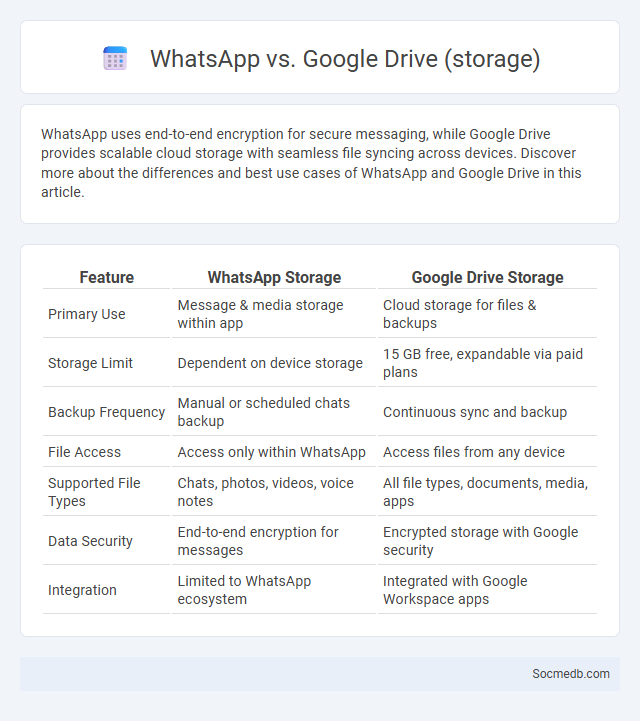
Photo illustration: WhatsApp vs Google Drive (storage)
WhatsApp uses end-to-end encryption for secure messaging, while Google Drive provides scalable cloud storage with seamless file syncing across devices. Discover more about the differences and best use cases of WhatsApp and Google Drive in this article.
Table of Comparison
| Feature | WhatsApp Storage | Google Drive Storage |
|---|---|---|
| Primary Use | Message & media storage within app | Cloud storage for files & backups |
| Storage Limit | Dependent on device storage | 15 GB free, expandable via paid plans |
| Backup Frequency | Manual or scheduled chats backup | Continuous sync and backup |
| File Access | Access only within WhatsApp | Access files from any device |
| Supported File Types | Chats, photos, videos, voice notes | All file types, documents, media, apps |
| Data Security | End-to-end encryption for messages | Encrypted storage with Google security |
| Integration | Limited to WhatsApp ecosystem | Integrated with Google Workspace apps |
Introduction to WhatsApp and Google Drive Storage
WhatsApp is a widely-used messaging application that enables instant communication through text, voice, and video calls, supporting over 2 billion active users globally. Google Drive offers 15 GB of free cloud storage integrated with WhatsApp, allowing users to back up chats, photos, and videos securely and access them across multiple devices. This seamless integration enhances data management and ensures users maintain control over their digital content within social media environments.
How WhatsApp Uses Storage
WhatsApp uses storage by saving chat messages, images, videos, and voice notes directly on Your device, allowing easy offline access. Media files are stored in dedicated folders within Your phone's internal storage or SD card, depending on your settings, effectively managing local data usage. Backup options through Google Drive or iCloud optimize storage by securely archiving conversations without occupying physical device space.
Overview of Google Drive Storage Options
Google Drive offers multiple storage options tailored to suit individual and business needs, ranging from 15 GB of free space to scalable plans with up to 2 TB or more available via Google One subscriptions. Your files, photos, and videos remain securely stored with seamless access across devices, enhancing your ability to manage social media content efficiently. Choosing the right storage option ensures smooth performance for uploading, sharing, and collaborating on large multimedia files critical for maintaining an active online presence.
Storage Management Features in WhatsApp
WhatsApp's storage management features enable users to view and control the space occupied by chats, media files, and documents efficiently. The Storage Usage section categorizes data by chat, allowing selective deletion of large files and outdated content to free up device memory. Regular updates enhance these tools, improving user experience through optimized storage clearance and better performance.
Storage Management Tools in Google Drive
Google Drive offers robust storage management tools that help users efficiently organize and free up space by identifying large files, duplicate documents, and unused apps. The Storage Management feature categorizes data into Trash, Large Files, and Shared with Me, allowing precise control over digital content. Leveraging these tools optimizes cloud storage capacity, ensuring smooth social media content management and seamless collaboration.
Backup and Restore: WhatsApp vs Google Drive
WhatsApp offers a built-in backup feature that allows you to save your chat history locally or to the cloud, supporting seamless restore processes when switching devices or recovering lost data. Google Drive integration with WhatsApp enables automatic, encrypted backups of messages, photos, and videos, ensuring your conversations are securely stored and easily retrievable. When managing your social media data, leveraging WhatsApp's backup alongside Google Drive's cloud storage enhances your ability to safeguard and restore your personal information efficiently.
Storage Limits: Comparing WhatsApp and Google Drive
WhatsApp limits media storage within chats by using your device's memory, often restricting backups to a maximum size of 2 GB on Google Drive for free accounts. Google Drive offers 15 GB of free cloud storage shared across Gmail, Google Photos, and Drive, allowing you to manage larger files beyond WhatsApp's backup constraints. Understanding these storage limits helps you optimize your data management and ensures your important WhatsApp messages and media are securely backed up without exceeding your Google Drive capacity.
File Types Supported and Restrictions
Social media platforms support a variety of file types, including JPEG, PNG, and GIF for images, MP4 and MOV for videos, and MP3 or WAV for audio files, ensuring broad compatibility for user content. Restrictions often apply to file size, resolution, and duration, with common limits such as a maximum video length of 60 seconds on Instagram or a 15 MB file size cap on Twitter images. Understanding these specifications helps you optimize your uploads for faster processing and better display quality across different social media channels.
Data Security and Privacy Considerations
Social media platforms handle vast amounts of personal data, making data security and privacy considerations critical to protect users from unauthorized access, identity theft, and data breaches. Implementing strong encryption protocols, multi-factor authentication, and regular security audits enhances protection against cyber threats. Users should also be educated on privacy settings and data sharing risks to maintain control over their personal information.
Best Practices for Effective Storage Management
Efficient social media storage management relies on organizing digital assets with clear metadata tags and consistent file naming conventions to enable quick retrieval and reduce redundancy. Leveraging cloud-based storage solutions with scalable capacity and robust backup systems ensures data integrity and minimizes downtime during high traffic periods. Regularly auditing stored content and utilizing automated archiving tools helps maintain optimal storage performance and supports compliance with data governance policies.
 socmedb.com
socmedb.com